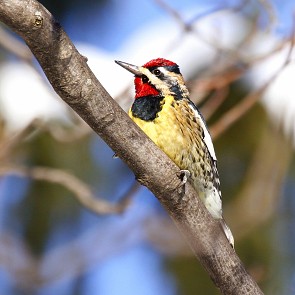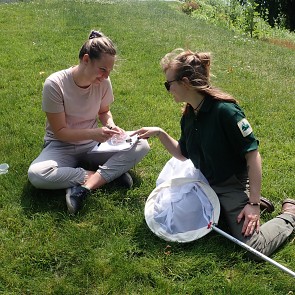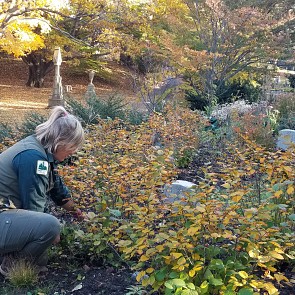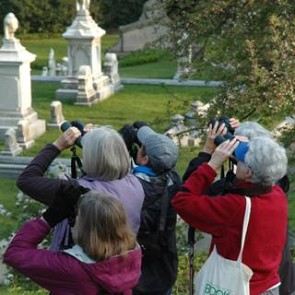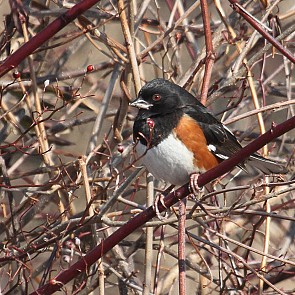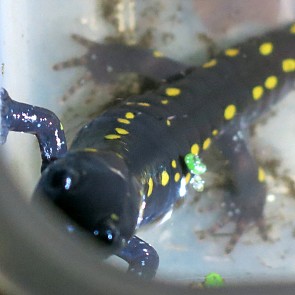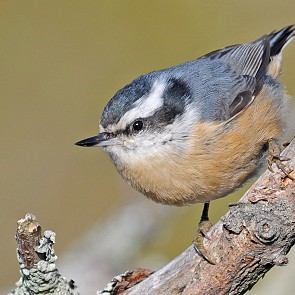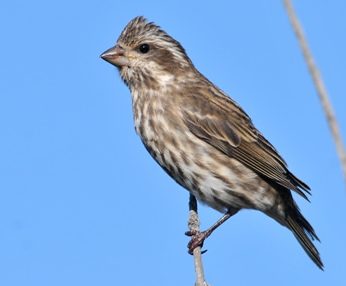The Purple Finch
Yes, this accompanying photograph by Jeremiah Trimble really is a Purple Finch. Females and immature males are brown with a bold whitish eyebrow stripe which distinguishes them from the plain faced House Finch which is much more common here in Massachusetts. The name Purple is also misleading for the color of the adult male; it’s more the color of raspberry.
Roger Tory Peterson described the Purple Finch as a “sparrow dipped in raspberry juice.” Here in Massachusetts we tend to see more first year birds, like the photograph, than the adult males. The Purple Finch is an uncommon breeder in Massachusetts and as far as I know it has not been noted to nest in Mount Auburn since the days of William Brewster, who wrote in his Birds of the Cambridge Region (1906).” The juniper woods which once covered so much of the country lying between Mount Auburn and the Watertown Arsenal, used to attract Purple Finches at all seasons, and the birds bred there so commonly at times that on June 6, 1869, I found no less than six nests containing eggs or young within a space of half an acre.” (more…)
Eternally Green: Highlighting Mount Auburn’s Rich, Natural Environment Through Theatre
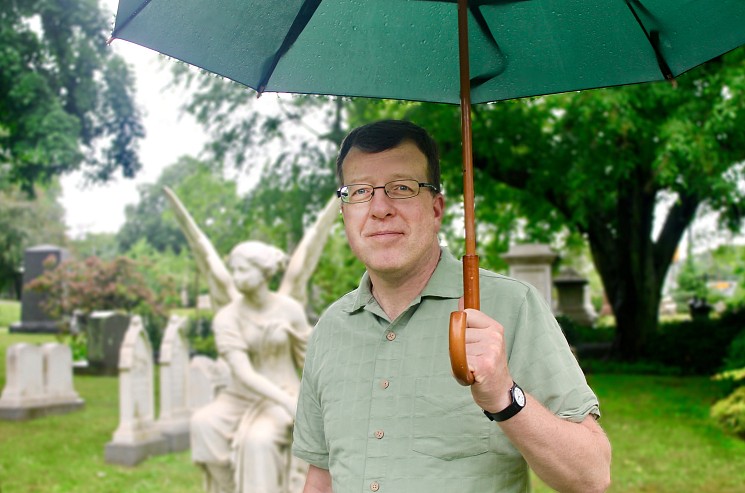
This article was written by Artist in Residence, Patrick Gabridge.
When I tell people I’m the artist-in-residence at Mount Auburn Cemetery, they are often shocked that such a thing exists and also very curious about what, as a playwright, I intend to do at a cemetery. Most folks assume I’ll be writing about the various people buried here. Which I will. But even from the very start of my residency this winter, I knew I wanted to write about the diverse and unique natural environment of Mount Auburn.
Since I started in January, I’ve been walking the grounds, toting binoculars with birders at dawn, looking for nighthawks at sunset on the tower, shining flashlights in Consecration Dell looking for spotted salamanders, and trying not to step on tiny toadlets by Halcyon Lake. And, more crucially for a playwright, I’ve been listening to the people who are deeply invested in protecting and improving the flora and fauna that make Mount Auburn such a special place.
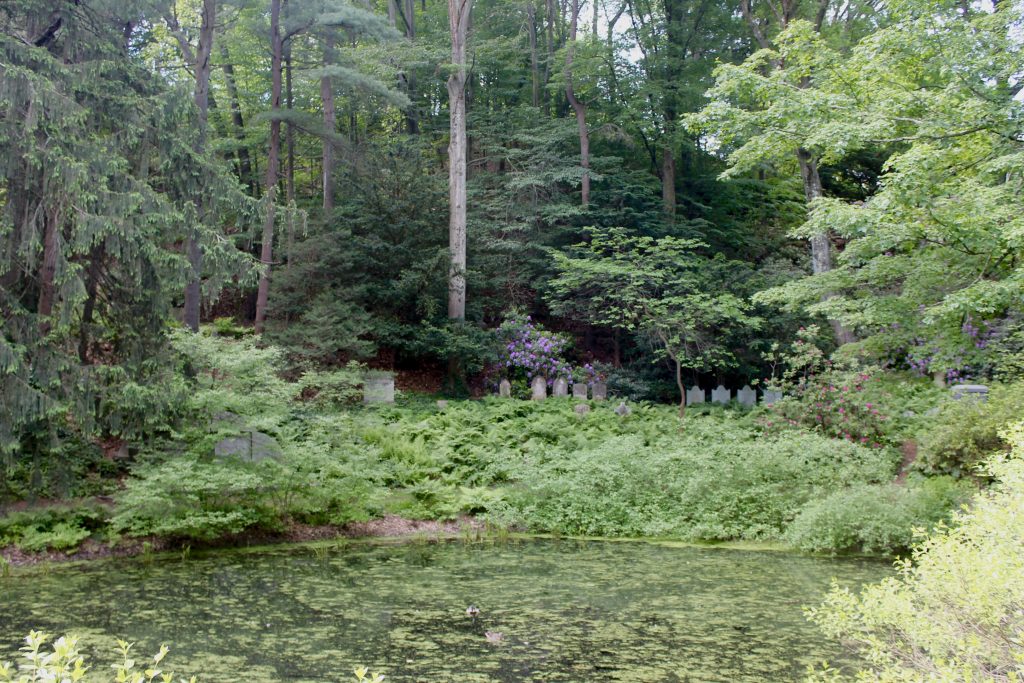
The challenge for a writer tasked with creating plays about Mount Auburn is the embarrassment of riches when it comes to potential stories. A hundred thousand tales are wrapped around the people interred here, and they are surrounded by hundreds of species of birds and trees, and thousands upon thousands of plants, all of them tended by dedicated stewards.
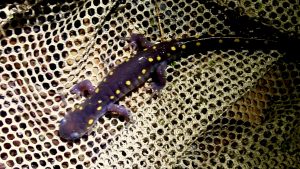
Spotted Salamander in Consecration Dell
In the end, I chose to create two series of short plays–one mostly about historical figures buried here and their role and relationship to the formation of American identity, and another set of nature plays. Some are already written and will be read on the grounds in September—like a short play called Hot Love in the Moonlight is about the mating habits of spotted salamanders. There will be a play about birds and birders (Cerulean Blue), and another about Asa Gray and Louis Agassiz. I’m still exploring play ideas around some of the secret mushroom spots that may or may not exist, and there will almost certainly be a play inspired by conversations with the grounds crew members who help Mount Auburn remain the gem that it is.
Beyond writing and research, the next step begins with reading and playing with the text with actors and audiences. This September, you will see me and Courtney O’Connor, my director, gathered with clumps of actors at Consecration Dell and near Auburn Lake, and other spots, with scripts in our hands, reading dialogue aloud. We’ll see if the structure and content of the work makes sense, if it has power, but also how it works in three-dimensions. How does it feel to have our voices and bodies in action on the actual grounds? It’s one thing for me to imagine how it all feels and sounds when I’m typing away in my office, but it’s entirely different when we have actors do it while standing on the edge of a pond.
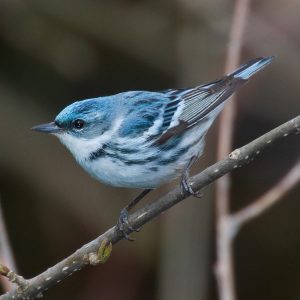
Cerulean Blue Warbler
At the public readings in September, we’ll start exploring what the plays feel like with an audience. (Plays are nothing without an audience.) When staging site-specific work there are additional concerns we don’t have in a traditional theatre, where the environment is controlled and well understood. We have to ask questions about where does the audience sit or stand, is there noise (traffic, neighbors) that will impact that site? How do the plants and topography affect where we can stand, how much sound reaches the audience, the visual palette? Entrances and exits are never simple when performing outdoors. How does the audience know when the show is over? And, in a cemetery, where do we perform such that we are respectful of the people who are buried here. How do we perform plays about nature, in nature, in ways that don’t harm the environment we’re talking about?
Having to answer all these questions, as we explore people and ideas in the text, is part of the challenge and fun of doing site-specific work. The other thing I truly love about this kind of theatre is that the barrier between the performers and audience is much more fluid and informal than in work created in a traditional spaces. The enormity and concreteness of the natural world around the very small play we’re creating helps unite the audience and performers.
In June of next year, we will fully stage the Nature Plays on the grounds, in a production that we hope will engage and delight audiences in all kinds of interesting ways. In the meantime, my team and I will be researching, writing, and playing, as we explore ways to illuminate the important natural elements of Mount Auburn Cemetery.
A Timetable of Migration at Mount Auburn in May
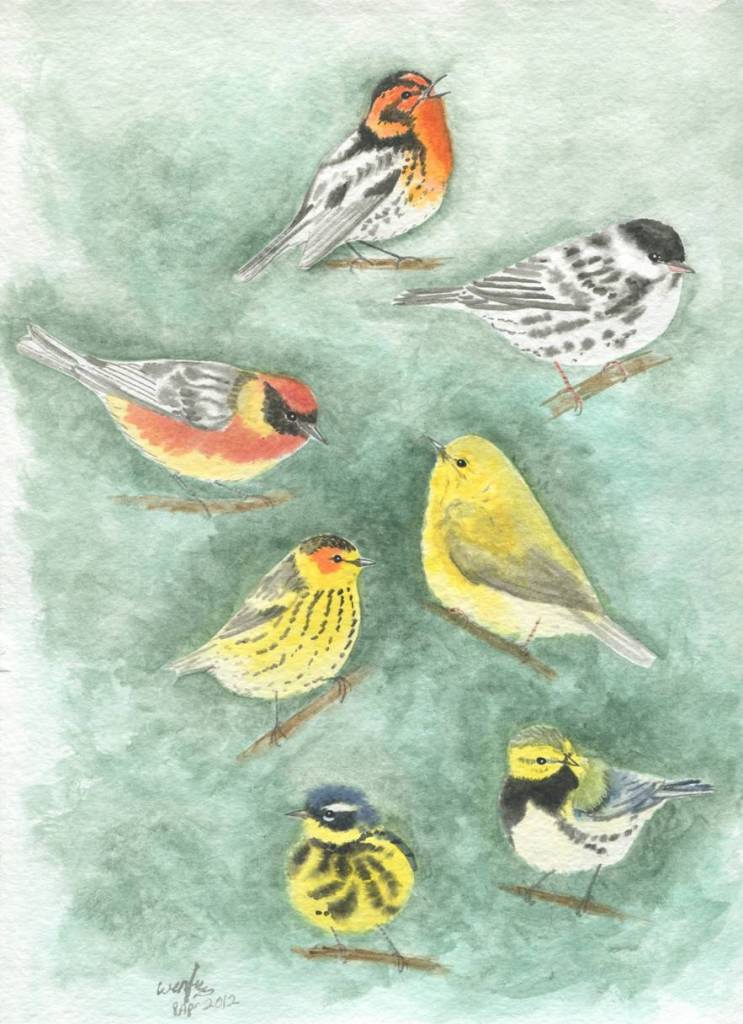
Setophaga Warblers Evergreen by Wenfei Tong
The month of May is when the peak abundance of migrant birds is found at Mount Auburn. In the following week by week timetable is a rather unscientific schedule of when you might expect the optimal time to see certain species. The third week of May is probably the week in which you could see close to 100 species in the Cemetery. This week you still have a few stragglers from the last days of April and the first few of the birds that come in the last days of May. Remember that as the month progresses, the foliage gets thicker, so the earlier in the season that you can find a migrant, the easier it will be to see it!
By the first week in May, many migrants will already be present such as Northern Flicker, Eastern Phoebe, Blue-headed Vireo, both Golden and Ruby crowned Kinglets, Hermit Thrush, Blue-gray Gnatcatcher, and the following early warblers: Yellow-rumped, Pine, Palm and Black and white, Chipping Sparrow and Eastern Towhee. (more…)
Eternally Green: Reintroducing the Wolves of the Forest Floor to Mount Auburn Cemetery
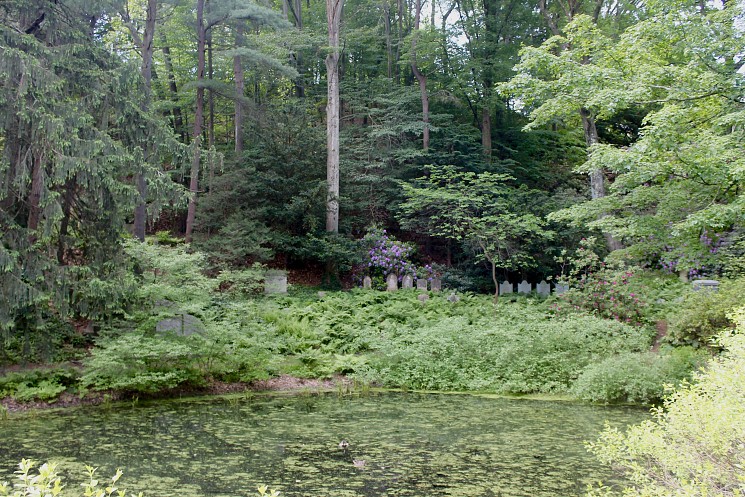
This article was written by ecologist, Brooks Mathewson
This spring my daughters and I tapped our Sugar Maple in the back yard. While standing over the boiling sap it occurred to me that just as forty ounces of maple sap is reduced to one ounce of maple syrup, the dozens of proposed solutions to climate change can be similarly reduced to three major strategies. The first two usually garner the most attention – consume less and produce energy in a cleaner way. However, there is a third critical part of the equation, although often overlooked, that must also be addressed. This is to sequester the excess carbon dioxide that is already in our atmosphere.
More carbon dioxide is in the atmosphere now than at any point in the last two to four million years. The last time carbon dioxide levels were above 400 parts per million, as they are today, sea levels were 100 feet higher and crocodiles lived in Greenland. Even if we were to completely end all carbon emissions tomorrow, we will still be left with a major problem.
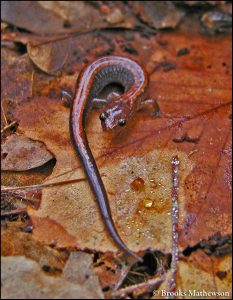
Carbon can be drawn out of the atmosphere through the conservation of healthy forests. Fifteen percent of the carbon emitted by humans in the United States is absorbed by forests. Two-thirds of this carbon is stored in the soil. If we are to have healthy, carbon absorbing forests, soil health is essential. Looking down at our feet may not be such a bad idea after all.
Healthy ecosystems need top-level predators, and in this region the most important top-level predator of the forest floor is the diminutive eastern red-backed salamander. These small, slender amphibians are fully terrestrial, breeding in moist locations under rocks and logs. Liberation from the stereotypical amphibian life cycle constraints has enabled red-backs to be widely distributed throughout the forest as opposed to within a narrow range of territory in close proximity to a wetland. In fact, red-backs are the most abundant vertebrate in the forest, with a biomass equivalent to twice that of all the breeding birds. By preying on soil invertebrates that shred leaves, red-backs slow down the rate at which leaf litter decomposes, immobilizing more carbon to be stored in the soil.
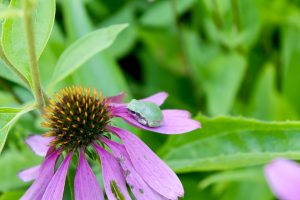
Surprisingly, extensive searches at Mount Auburn from 2013 to 2015 did not produce any observations of red-backed salamanders. One reason for their absence may be that the species was unable to survive through the period in the early 1900s when the Cemetery was more open with less extensive tree cover. Today, however, major ecological restoration efforts in the forest at Consecration Dell make this area of Mount Auburn an ideal spot to reintroduce a species that undoubtedly was present in the past.After receiving permission from the State of Massachusetts Division of Fisheries and Wildlife and the Watertown Conservation Commission, thirty-one eastern red-backed salamanders were reintroduced in the fall of 2017 to the upland woods in Consecration Dell. This spring another fifty red-backs will join them. Rough-cut, untreated, boards have been set out as habitat around the paths surrounding the Dell Pond. Over the course of year I will monitor these cover boards to assess the status of the reintroduced population of salamanders. It is our hope that red-backs will begin to successfully breed and join the other species of amphibians successfully reintroduced to Mount Auburn Cemetery by Dr. Joe Martinez in past years including American Toad, Spring Peepers, and Gray Tree Frog.
